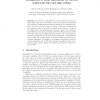Free Online Productivity Tools
i2Speak
i2Symbol
i2OCR
iTex2Img
iWeb2Print
iWeb2Shot
i2Type
iPdf2Split
iPdf2Merge
i2Bopomofo
i2Arabic
i2Style
i2Image
i2PDF
iLatex2Rtf
Sci2ools
ICIAR
2010
Springer
2010
Springer
Recognition of Facial Expressions by Cortical Multi-scale Line and Edge Coding
Abstract. Face-to-face communications between humans involve emotions, which often are unconsciously conveyed by facial expressions and body gestures. Intelligent human-machine interfaces, for example in cognitive robotics, need to recognize emotions. This paper addresses facial expressions and their neural correlates on the basis of a model of the visual cortex: the multi-scale line and edge coding. The recognition model links the cortical representation with Paul Ekman’s Action Units which are related to the different facial muscles. The model applies a top-down categorization with trends and magnitudes of displacements of the mouth and eyebrows based on expected displacements relative to a neutral expression. The happy vs. not-happy categorization yielded a correct recognition rate of 91%, whereas final recognition of the six expressions happy, anger, disgust, fear, sadness and surprise resulted in a rate of 78%.
Different Facial Muscles | Facial Expressions | ICIAR 2010 | Image Analysis | Intelligent Human-machine Interfaces |
| Added | 26 Jan 2011 |
| Updated | 26 Jan 2011 |
| Type | Journal |
| Year | 2010 |
| Where | ICIAR |
| Authors | R. J. R. de Sousa, J. M. F. Rodrigues, J. M. Hans du Buf |
Comments (0)

